If you are considering adding clown loaches to your aquarium, it is important to understand their unique needs and requirements.
In this comprehensive guide, we will cover everything you need to know about caring for clown loaches, from their origin and natural habitat to their behavior and temperament.
We will also discuss how to set up the perfect aquarium for these fascinating fish, provide insights into their diet and feeding habits, and offer tips on maintaining their health and wellness.
Understanding Clown Loaches
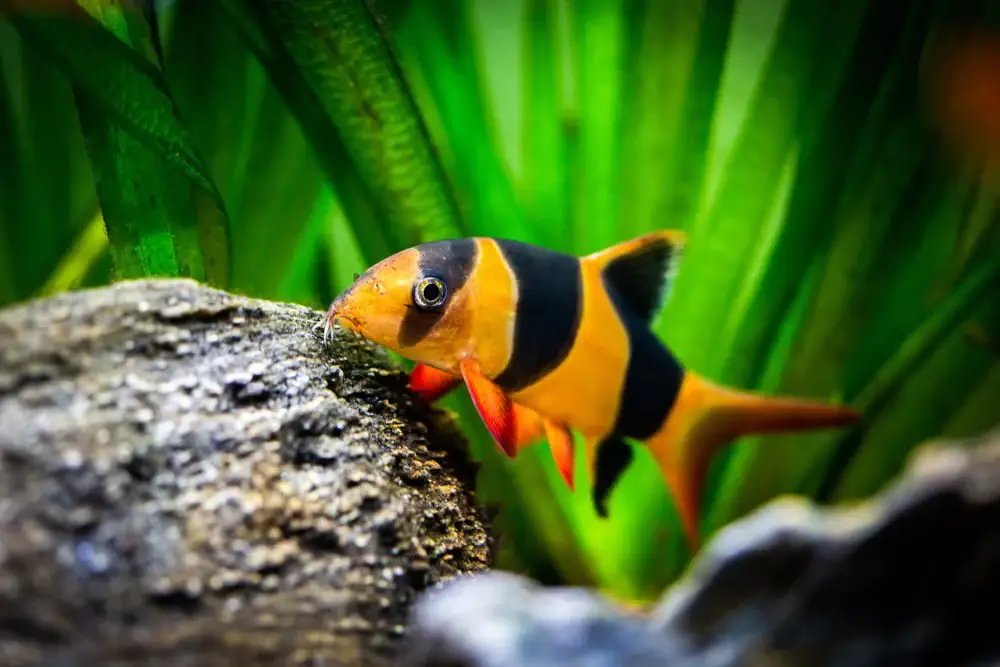
Clown loaches, scientifically known as Chromobotia macracanthus, are freshwater fish native to the rivers and streams of Indonesia. They belong to the family Botiidae and are highly sought after by aquarium enthusiasts for their vibrant colors and playful nature.
The Origin and Natural Habitat of Clown Loaches

In the wild, clown loaches can be found in the warm, slow-moving waters of Sumatra and Borneo. They prefer densely vegetated areas, where they can find shelter and forage for food.
The lush greenery provides them with a sense of security and allows them to exhibit their natural behavior. The dense vegetation also serves as a natural filtration system, keeping the water clean and oxygenated.
Within their natural habitat, clown loaches form tight-knit social groups, often consisting of dozens of individuals. These groups provide them with a sense of belonging and safety.
They establish hierarchies within the group, with dominant individuals taking charge of leading the group to feeding grounds and protecting the territory.
Physical Characteristics of Clown Loaches
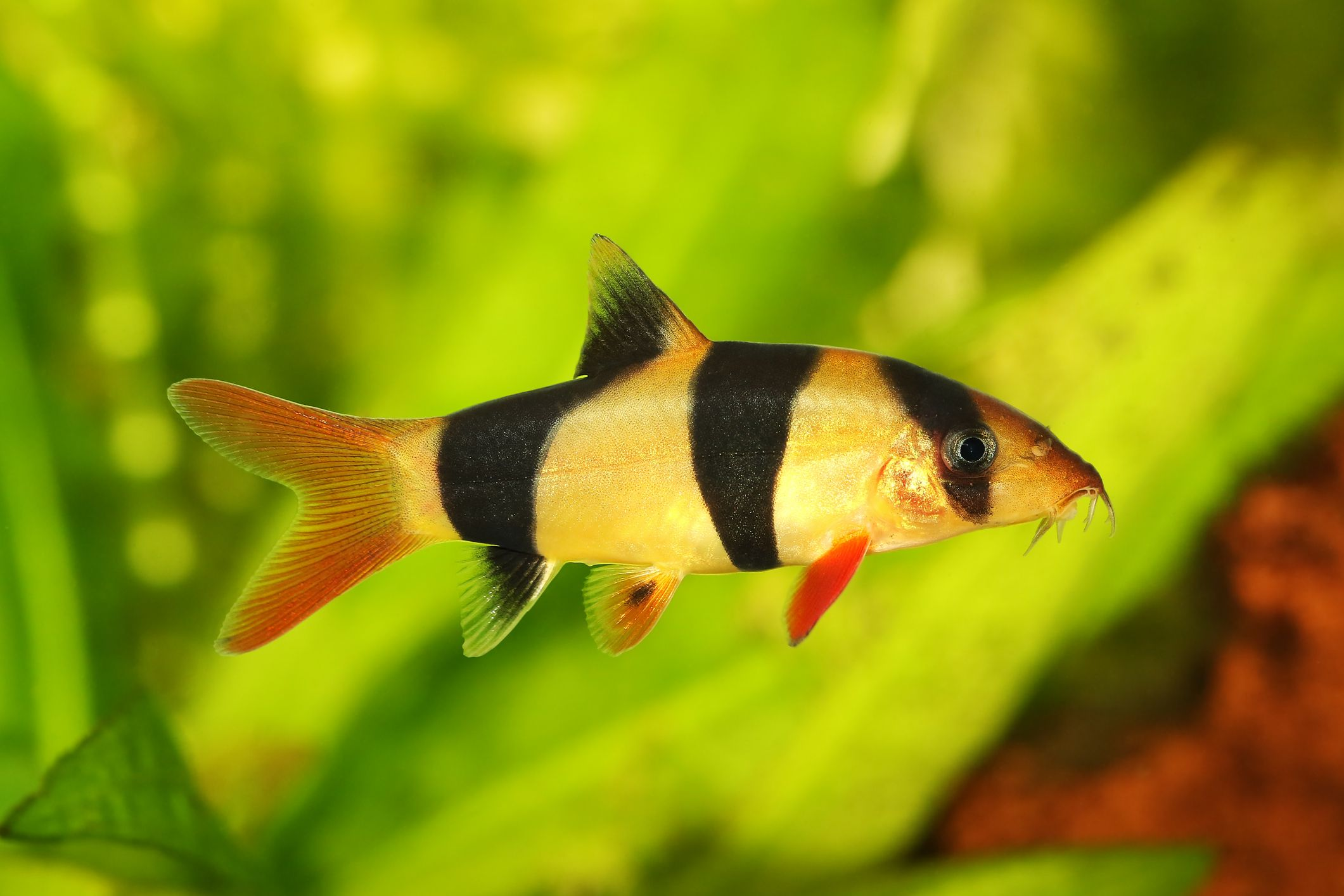
When it comes to captivating inhabitants of the aquatic realm, clown loaches (Chromobotia macracanthus) stand out with their striking and captivating bright orange bodies adorned with bold black stripes.
Delving into their physical attributes offers an intriguing glimpse into their unique nature.
Size and Appearance
As adult clown loaches mature, they can grow up to an impressive 12 inches in length. This size makes them a noticeable presence in any aquarium, captivating observers with their lively antics.
Their coloration, characterized by the vibrant contrast between the bright orange base and deep black markings, is a true spectacle.
Distinctive Markings and Stripes
One of the most recognizable features of a clown loach is its striking pattern of black stripes that traverse its body. These markings serve not only as a visual spectacle but also have a practical purpose in providing camouflage and aiding in their survival in their natural clown loach habitat.
Active Swimmers and Social Behavior

Clown loaches are known for their schooling fish behavior, thriving in the company of their peers. Observing a group of these fish in a clown loach tank reveals their energetic and active nature.
Their constant movement and social interactions make them a captivating focal point in any aquarium.
A Peaceful Presence
Despite their energetic tendencies, clown loaches are generally peaceful fish with a friendly demeanor. While occasional conflicts may arise, especially during feeding, they typically coexist harmoniously with a variety of tank mates, particularly those that exhibit a calm and peaceful freshwater fish disposition.
Intriguing Inhabitants for Your Aquarium
The physical characteristics of clown loaches contribute to their allure as captivating aquarium inhabitants. Their vibrant coloration, distinctive markings, and active behavior make them a popular choice among aquarists seeking an engaging and visually stunning addition to their fish tank.
Whether you’re admiring their bold stripes or marveling at their school’s synchronized movements, clown loaches are sure to leave a lasting impression as they gracefully navigate their underwater world.
Behavior and Temperament of Clown Loaches
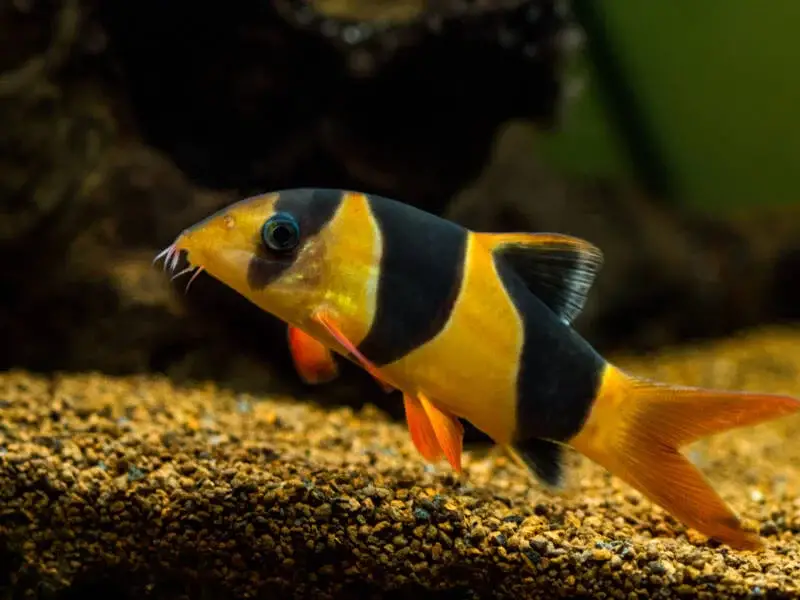
When it comes to the captivating world of aquarium fish, few species are as intriguing and captivating as clown loaches (Chromobotia macracanthus).
These bright orange and boldly striped creatures have a unique charm that aquarium enthusiasts find irresistible. Understanding the temperament of clown loaches is key to creating a harmonious aquatic environment.
Schooling Nature and Social Behavior

Clown loaches are renowned for their schooling fish behavior. They thrive when surrounded by their own kind, displaying a remarkable sense of community and camaraderie. In your aquarium, consider keeping a group of adult clown loaches to witness their engaging interactions.
The presence of companionship not only enhances their well-being but also brings out their true colors, showcasing their striking appearance.
Peaceful Demeanor and Interaction with Tank Mates
The temperament of clown loaches is generally peaceful, making them suitable for a variety of community tank setups. They tend to be amicable toward other fish species, particularly those with a peaceful freshwater fish disposition.
Careful consideration should be given to selecting appropriate clown loach tank mates to ensure a harmonious coexistence.
Exploring Their Habitat and Behavior
Originating from the waterways of Southeast Asia, clown loaches are accustomed to environments with slow-moving waters and abundant cover, such as floating plants and rocky crevices at the bottom of the tank. Mimicking these features in your clown loach tank setup can encourage natural behaviors and reduce stress.
Eating Habits and Natural Instincts

In the wild, clown loaches eat a varied diet, including small invertebrates, crustaceans like brine shrimp, and plant matter.
In captivity, their diet can consist of high-quality flakes, sinking shrimp pellets, and algae wafers. Their tendency to consume snails also makes them a natural solution for controlling pest populations in your aquarium.
A Unique and Engaging Addition
The behavior and temperament of clown loaches add a layer of fascination to the world of aquarium keeping. Their social tendencies, peaceful demeanor, and colorful presence make them a prized choice among freshwater enthusiasts.
As you observe these clown loaches swimming gracefully and interacting within their aquatic realm, you’ll undoubtedly appreciate the charm and allure they bring to your fishkeeping journey.
Tank Mates for Clown Loaches: Finding the Perfect Aquarium Cohabitants
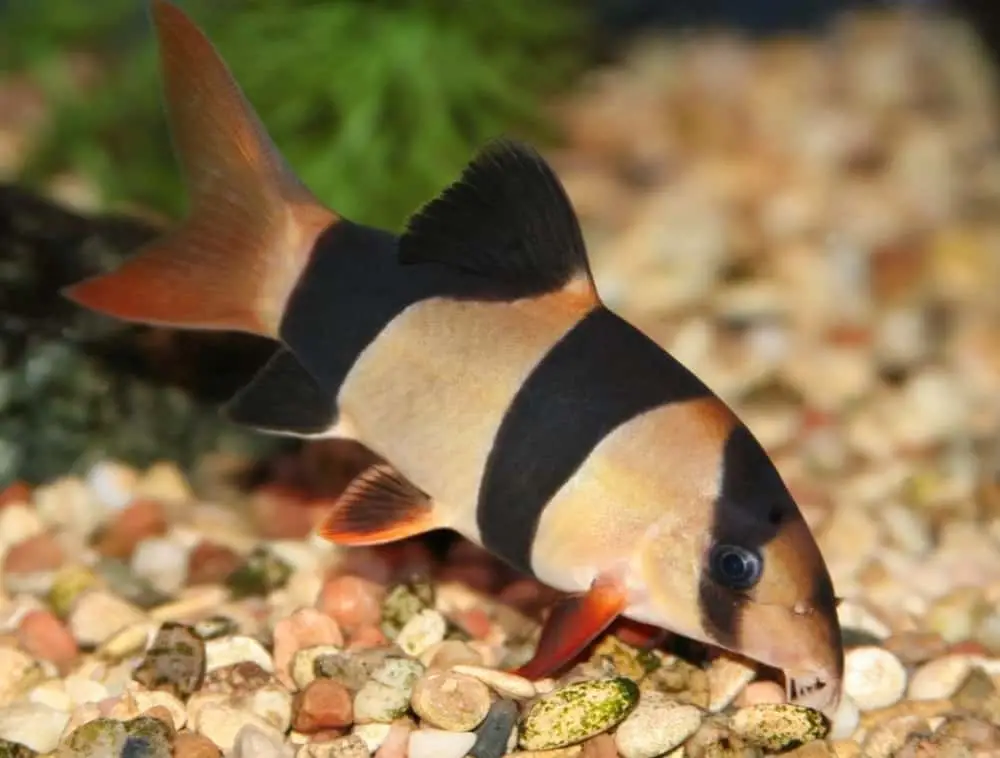
When creating an aquarium ecosystem, choosing suitable tank mates for clown loaches is an art that blends harmony and diversity. These playful, vibrant fish thrive in communal setups, but a thoughtful approach is crucial to ensure their well-being and compatibility.
Let’s dive into the world of aquatic camaraderie and explore how to select the right companions for your clown loaches.
Before selecting tank mates, it’s essential to acquaint yourself with the unique characteristics of clown loaches. These charming creatures hail from Southeast Asia and are known for their distinctive coloration and sociable nature.
With their playful antics and intriguing behavior, clown loaches can be a captivating centerpiece in your aquatic realm.
Ideal Tank Size for Clown Loaches
First things first, ensure your aquarium provides ample space for your clown loaches to roam and flourish. A suitable tank size is essential, with experts recommending a minimum of 75 gallons to accommodate a small school of these fish.
A spacious environment not only supports their physical growth but also minimizes stress and territorial disputes.
Selecting Compatible Tank Mates
When considering companions for your clown loaches, prioritize species that share a similar temperament and environmental preferences. Some potential tank mates include:
- Corydoras Catfish: These bottom-dwellers complement clown loaches well, and their peaceful nature promotes a harmonious coexistence.
- Bristlenose Plecos: Known for their algae-eating prowess, plecos help maintain a clean tank while peacefully inhabiting the same space as clown loaches.
- Rasboras and Tetras: Small, non-aggressive fish like neon tetras or harlequin rasboras can add color and movement to your aquarium without causing conflicts.
Diverse Hiding Places
Clown loaches are naturally drawn to hiding spots. Integrate decorative elements like caves, driftwood, and plants to provide secure retreats for both clown loaches and their tank mates. This promotes a sense of security and minimizes stress-induced behaviors.
Maintaining Water Conditions
Consistency in water parameters is key to a thriving aquatic community. Clown loaches prefer slightly acidic to neutral water with temperatures ranging between 75°F and 86°F (24°C – 30°C).
Ensure proper filtration and regular water changes to maintain water quality and support the health of all inhabitants.
Observation and Compatibility Testing
As you introduce potential tank mates, closely monitor their interactions. Observe any signs of aggression, stress, or compatibility. It’s recommended to introduce new fish gradually and in small groups to minimize disruptions in the established hierarchy.
Beware of Overcrowding
While it’s tempting to create a bustling underwater world, avoid overstocking your aquarium. Overcrowding can lead to heightened stress levels, increased competition for resources, and compromised water quality.
A balanced, well-stocked tank ensures the overall well-being of your aquatic community.
Creating a harmonious aquatic environment with suitable tank mates for your clown loaches requires careful consideration and an understanding of their social dynamics.
By providing adequate space, selecting compatible companions, and maintaining optimal water conditions, you can curate a captivating and thriving underwater realm that showcases the beauty and charm of these captivating clown loaches.
Nutrition and Feeding
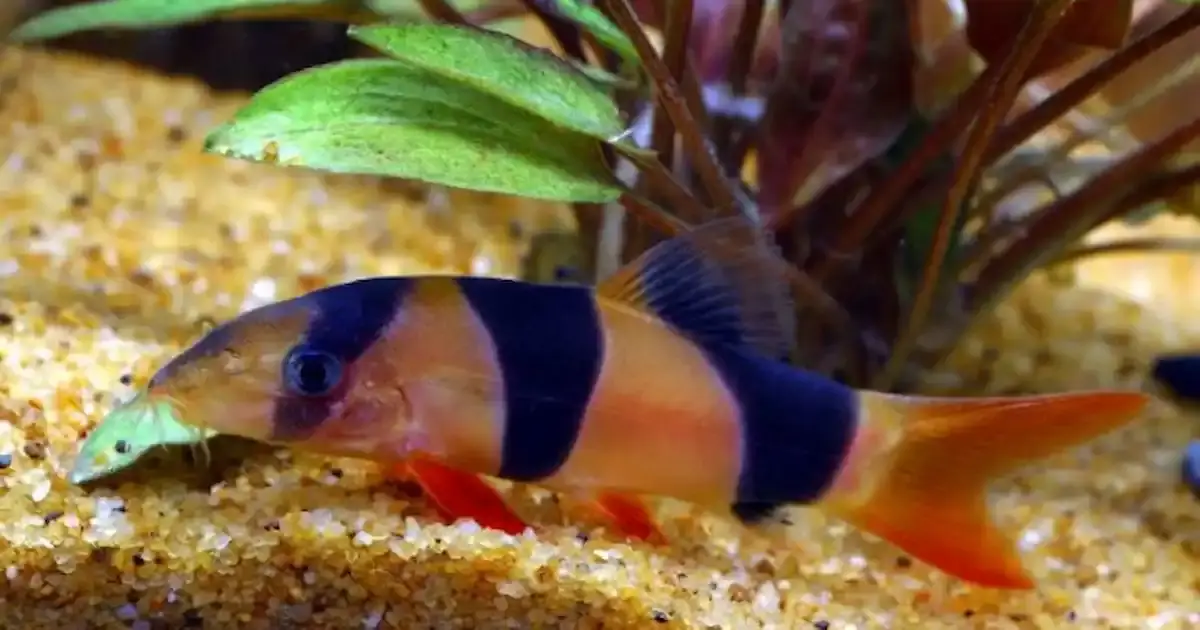
Providing a well-balanced diet is crucial for the overall health and vitality of clown loaches. These omnivorous fish have unique dietary requirements that should be met to ensure their well-being.
Clown loaches, also known as Chromobotia macracanthus, are native to the rivers and streams of Indonesia. In their natural habitat, these colorful fish feed on a variety of foods, including small invertebrates, worms, and plant matter.
To replicate their natural diet in the aquarium, it is recommended to offer a combination of high-quality sinking pellets or flakes, frozen or live foods such as brine shrimp and bloodworms, and occasional fresh vegetables.
When it comes to selecting the best foods for clown loaches, there are several commercially available options specifically formulated to meet their nutritional needs. Look for pellets or flakes that contain a high protein content and essential vitamins and minerals.
These foods are designed to promote healthy growth and vibrant coloration in your clown loaches.
While commercially available foods are a great staple, it is also important to supplement their diet with occasional treats. Freeze-dried foods, such as daphnia or tubifex worms, can provide a welcome variety to their meals.
Additionally, blanched vegetables like zucchini and spinach can be offered as a nutritious snack. These vegetables not only provide essential nutrients but also help with the digestion of other foods.
When it comes to feeding schedule and practices, it is important to consider the clown loaches’ high metabolic rate. These active fish require small amounts of food multiple times a day. This frequent feeding pattern mimics their natural foraging behavior and ensures that they receive the necessary nutrients to thrive.
However, it is crucial not to overfeed them. Overfeeding can lead to obesity, which can have detrimental effects on their health and lifespan.
To maintain a healthy weight, monitor their feeding habits closely and adjust the amount of food accordingly. It is recommended to observe their behavior during feeding time. If they consume all the food within a few minutes, you can gradually increase the portion size.
On the other hand, if there is leftover food after a few minutes, reduce the amount of food offered to prevent overfeeding and water quality issues.
In addition to monitoring their feeding habits, it is important to maintain a clean and well-maintained aquarium. Regular water changes and filtration will help maintain optimal water quality, which is crucial for the overall health and well-being of your clown loaches.
By providing a diverse and nutritious diet, along with a suitable feeding schedule and proper aquarium maintenance, you can ensure that your clown loaches thrive and display their vibrant colors and playful behavior for years to come.
Health and Wellness

Keeping your clown loaches healthy and disease-free requires proper care and attention. By following some preventive measures and having a good understanding of common health issues, you can ensure their well-being for years to come.
Common Health Issues in Clown Loaches
Clown loaches are generally hardy fish, but there are a few common health issues that owners should be aware of. They can be susceptible to parasitic infections, such as Ich (white spot disease) and skin flukes. It is important to closely monitor their behavior and appearance for any signs of illness.
Preventive Measures and Treatments
To prevent disease outbreaks, maintaining optimal water conditions and a clean aquarium environment is essential. Regular water changes, routine water parameter testing, and quarantine procedures for new fish introductions can help minimize the risk of infections.
There are various treatments available for common fish diseases, but consulting a veterinarian or aquatic specialist is recommended for accurate diagnosis and treatment options.
Caring for clown loaches requires a comprehensive understanding of their origin, behavior, and specific care needs. From setting up an appropriate aquarium to providing a balanced diet and maintaining their health, following these guidelines will ensure the well-being and happiness of your clown loaches in your home aquarium.
Happy fishkeeping!
Breeding Clown Loaches: Unlocking the Enigma of Captive Propagation
Clown loaches, those vivacious members of the aquatic realm, have long been a subject of fascination for aquarists. These schooling fish with their distinctive bright orange hue and captivating black stripes, clown loaches have a personality that’s as vibrant as their appearance.
Whether you’re a seasoned clown loach owner or a novice aquarist intrigued by their allure, delving into the realm of breeding clown loaches is a journey worth undertaking.
Understanding the Clown Loach Habitat and Behavior
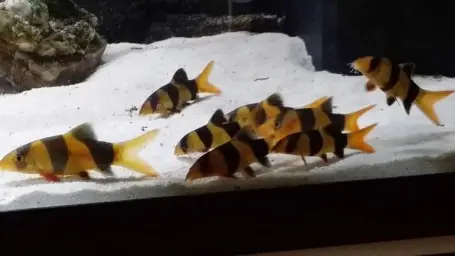
In the wild, these bottom-dwelling fish thrive in the lush waters of their native Southeast Asian habitats.
In a home aquarium setup, mimicking their natural surroundings becomes paramount. Provide ample hiding spots amidst floating plants and ensure the tank size is spacious enough to accommodate their lively antics.
The clown loach tank must be a harmonious community, comprising compatible tank mates like tiger botia or peaceful freshwater fish.
The Intricacies of Clown Loach Breeding
While clown loaches tend to be more challenging to breed than the typical aquarium fish, the rewards of successful propagation are immeasurable.
Creating the perfect environment involves maintaining precise water parameters, offering a balanced clown loach diet that includes brine shrimp, sinking shrimp pellets, and algae wafers.
Breeding clown loaches requires dedication, but observing the development of juvenile clown loaches from their embryonic stage to becoming lively members of your aquarium community is an awe-inspiring experience.
Venturing into the realm of breeding clown loaches unveils a captivating world of intricacies and wonders. As you meticulously craft an environment mirroring their clown loach habitat, you embark on a journey of discovery and connection with these lively, bright orange beings.
While breeding clown loaches demands patience and commitment, the fulfillment of witnessing new life blossoming within your aquarium is a testament to the beauty and resilience of nature.
FAQs
How Large Do Clown Loaches Grow?
Clown loaches can grow quite large, reaching up to 12 to 16 inches (30 to 40 cm) in length in the right conditions. However, they may not attain their full size in aquariums due to various factors.
What Is The Recommended Aquarium Size For Clown Loaches?
Clown loaches are active and social fish, so they require a spacious aquarium. A tank size of at least 75 gallons is recommended for a small group of clown loaches.
Can I Keep A Single Clown Loach, Or Do They Need To Be In Groups?
Clown loaches are social creatures and thrive best in groups of three or more. Keeping a single clown loach can lead to stress and health issues.
What Are The Ideal Water Parameters For Clown Loaches?
Clown loaches prefer slightly acidic to neutral water with a pH range of 6.0 to 7.5. The water temperature should be maintained between 75°F to 86°F (24°C to 30°C).
What Should I Feed My Clown Loaches?
Clown loaches are omnivores. Their diet should include high-quality pellets, flakes, frozen or live foods like bloodworms, brine shrimp, and vegetables like zucchini and spinach.

